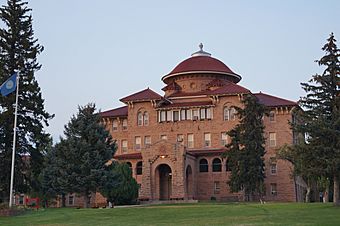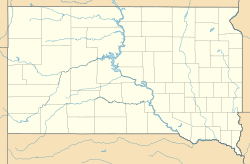Battle Mountain Sanitarium facts for kids
|
Battle Mountain Sanitarium, National Home for Disabled Volunteer Soldiers
|
|
 |
|
| Location | 500 North 5th St., Hot Springs, South Dakota |
|---|---|
| NRHP reference No. | 11000561 |
Quick facts for kids Significant dates |
|
| Added to NRHP | June 17, 2011 |
| Designated NHLD | June 17, 2011 |
The Battle Mountain Sanitarium was a special hospital for soldiers who were injured or sick. It was part of the National Home for Disabled Volunteer Soldiers (NHDVS). This hospital was built in Hot Springs, South Dakota.
It started in 1902 and opened its doors in 1907. This place was unique because it was only for medical care. It didn't have homes for soldiers to live in permanently. The sanitarium helped soldiers with problems in their bones, muscles, and joints. People believed the mineral springs in the area could help them heal. It also treated serious lung illnesses like tuberculosis, as the dry air was thought to be good for recovery.
The buildings look very cool with their Romanesque and Mission Revival styles. Today, these buildings are part of the Black Hills Health Care facility. The United States Department of Veterans Affairs (VA) runs it now. In 2011, most of the site became a National Historic Landmark. This was because of its amazing architecture and important history.
What is the Battle Mountain Sanitarium?
The Battle Mountain Sanitarium is located in Hot Springs, South Dakota. It sits on a bluff overlooking the Fall River. The campus covers about 68 acres. It used to be over 100 acres!
The outdoor areas were designed in the early 1900s. A landscape architect named George Kessler planned them. The main buildings were designed by Thomas Rogers Kimball. He was an architect from Omaha, Nebraska.
What are the Buildings Like?
Kimball's buildings are made from pink sandstone. This stone was dug up right there in the local area. The buildings mix two cool styles: Mission Revival and Richardsonian Romanesque. These styles were popular in Hot Springs back then.
The way the stone, design, and location come together makes the place look very striking. The main building has a round center. Wings spread out from it like spokes on a wheel.
How Did the Sanitarium Start?
The city of Hot Springs became a popular resort town in the 1880s. Visitors came because they thought the mineral springs had healing powers. Local people and leaders asked the government to build a soldiers' home there.
Congress said yes in 1902. One of the local spring owners agreed to give water to the new facility. Construction began, and the hospital opened in 1907.
From the very beginning, it was a treatment center for soldiers. They believed drinking or bathing in the hot spring waters would help them. It was also thought to be a good place to treat tuberculosis. However, the buildings weren't perfectly designed for this.
In 1930, the facility became part of the VA. Over time, it changed into a more general hospital. Some parts, like old tuberculosis wards, were taken down.



